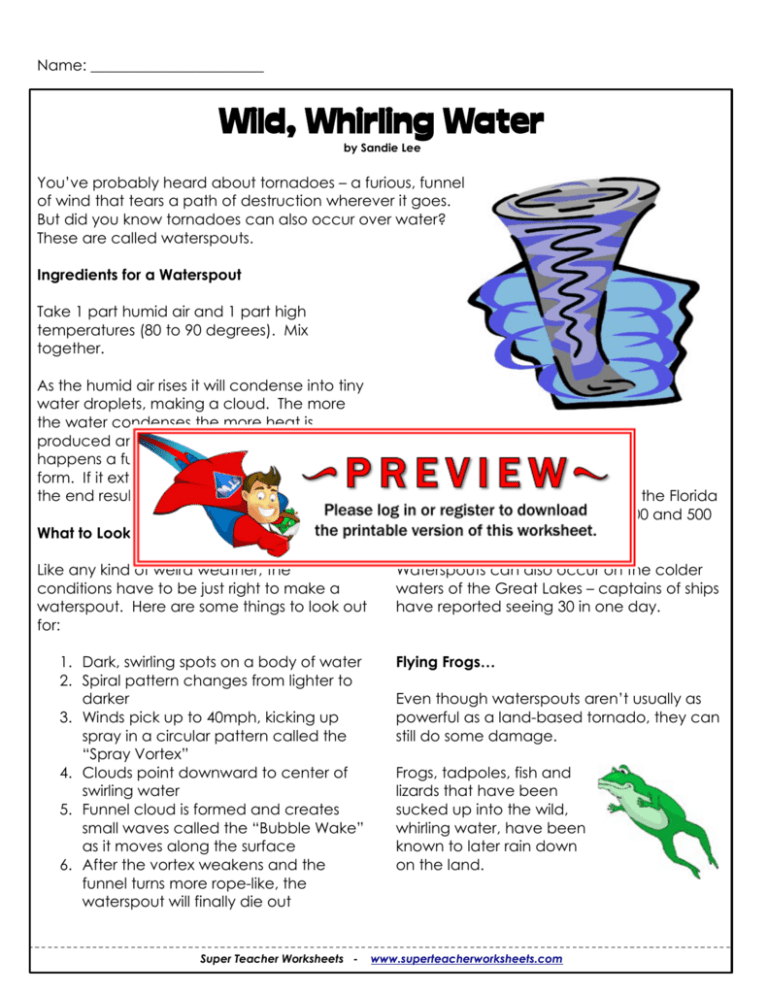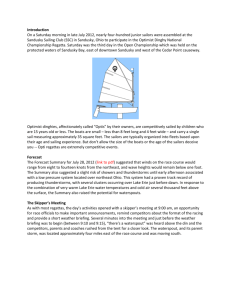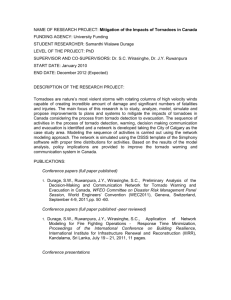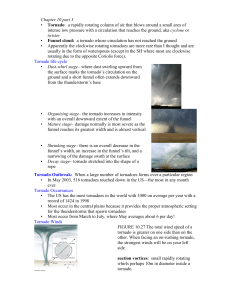Wild, Whirling Water - Super Teacher Worksheets
advertisement

Name: _______________________ Wild, Whirling Water by Sandie Lee You’ve probably heard about tornadoes – a furious, funnel of wind that tears a path of destruction wherever it goes. But did you know tornadoes can also occur over water? These are called waterspouts. Ingredients for a Waterspout Take 1 part humid air and 1 part high temperatures (80 to 90 degrees). Mix together. As the humid air rises it will condense into tiny water droplets, making a cloud. The more the water condenses the more heat is produced and the faster it will rise. Once this happens a funnel-shaped cloud can quickly form. If it extends towards a body of water, the end result is a waterspout. What to Look For Like any kind of weird weather, the conditions have to be just right to make a waterspout. Here are some things to look out for: 1. Dark, swirling spots on a body of water 2. Spiral pattern changes from lighter to darker 3. Winds pick up to 40mph, kicking up spray in a circular pattern called the “Spray Vortex” 4. Clouds point downward to center of swirling water 5. Funnel cloud is formed and creates small waves called the “Bubble Wake” as it moves along the surface 6. After the vortex weakens and the funnel turns more rope-like, the waterspout will finally die out Super Teacher Worksheets - Waterspout Occurrences Waterspouts are very common in the Florida Keys, in fact they see between 400 and 500 per year. Waterspouts can also occur on the colder waters of the Great Lakes – captains of ships have reported seeing 30 in one day. Flying Frogs… Even though waterspouts aren’t usually as powerful as a land-based tornado, they can still do some damage. Frogs, tadpoles, fish and lizards that have been sucked up into the wild, whirling water, have been known to later rain down on the land. www.superteacherworksheets.com Name: _______________________ Wild, Whirling Water by Sandie Lee 1. How is a waterspout like a tornado? _____________________________________________________________________________________ _____________________________________________________________________________________ 2. How is a waterspout different from a tornado? _____________________________________________________________________________________ _____________________________________________________________________________________ 3. Tell whether each sentence is true or false. ________________ Waterspouts are usually more dangerous than tornadoes. ________________ Waterspouts can occur in the Great Lakes. ________________ A waterspout creates small waves as it moves along the water's surface. 4. Under which conditions is a waterspout most likely to occur? a. 50 degree air temperature, 80% humidity b. 70 degree air temperature, 20% humidity c. 88 degree air temperature, 10% humidity d. 82 degree air temperature, 90% humidity Something extra: With an adult at home, use the Internet to find pictures of waterspouts. Print out your favorite picture and bring it in to show the class. Super Teacher Worksheets - www.superteacherworksheets.com ANSWER KEY Wild, Whirling Water by Sandie Lee 1. How is a waterspout like a tornado? Answers may vary. Possible answer: Both waterspouts and tornadoes are funnel-shaped wind clouds. 2. How is a waterspout different from a tornado? A tornado forms over land. A waterspout forms over water. 3. Tell whether each sentence is true or false. false Waterspouts are usually more dangerous than tornadoes. true Waterspouts can occur in the Great Lakes. true A waterspout creates small waves as it moves along the water's surface. 4. Under which conditions is a waterspout most likely to occur? a. 50 degree air temperature, 80% humidity b. 70 degree air temperature, 20% humidity c. 88 degree air temperature, 10% humidity d. 82 degree air temperature, 90% humidity Something extra: With an adult at home, use the Internet to find pictures of waterspouts. Print out your favorite picture and bring it in to show the class. Super Teacher Worksheets - www.superteacherworksheets.com








